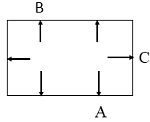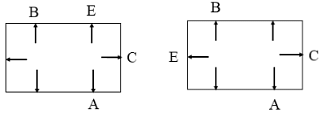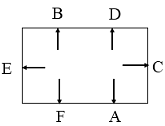CLAT Exam > CLAT Questions > Directions: There are six people A, B, C, D,...
Start Learning for Free
Directions: There are six people A, B, C, D, E, and F, seating around a rectangular table facing outwards. Four of them are seated at the longer sides (two people on each of the longer sides) and the remaining are seated at the shorter sides (one person on each of the shorter sides). D and E are not immediate neighbours. A is sitting diagonally opposite to B. F and D sit diagonally opposite to each other. B is sitting second to the left of C, who is sitting at the shorter side of the table. E is sitting two places away from A.
Q. What is the position of F from D?
- a)Fourth to the left
- b)Fourth to the right
- c)Second to the left
- d)Third to the right
Correct answer is option 'D'. Can you explain this answer?
Most Upvoted Answer
Directions: There are six people A, B, C, D, E, and F, seating around...
Positioning the People at the Table:
To solve this question, let's start by positioning the people at the table based on the given information:
1. A and B are sitting diagonally opposite to each other.
2. F and D sit diagonally opposite to each other.
3. B is sitting second to the left of C, who is sitting at the shorter side of the table.
4. E is sitting two places away from A.
Based on the given information, we can infer the following:
1. Since A and B are sitting diagonally opposite to each other, they must be sitting at the longer sides of the table.
2. F and D are sitting diagonally opposite to each other, so they must be sitting at the shorter sides of the table.
3. B is sitting second to the left of C, who is sitting at the shorter side of the table. Since B is sitting at the longer side, C must be sitting at the other shorter side.
4. E is sitting two places away from A. Since A is sitting at the longer side, E must be sitting at the other longer side.
Now, let's arrange the people at the table:
Longer Side:
A - E - B
Shorter Side:
C - D - F
Determining the Position of F from D:
To determine the position of F from D, we need to count the number of people between them in a clockwise direction.
Starting from D and moving clockwise, we have C, F, and then A before reaching E. So, F is third to the right of D.
However, we need to consider the seating arrangement where people are seated facing outwards. In this case, the position of F from D would be the opposite direction, which is third to the left.
Therefore, the correct answer is option (d) Third to the right.
To solve this question, let's start by positioning the people at the table based on the given information:
1. A and B are sitting diagonally opposite to each other.
2. F and D sit diagonally opposite to each other.
3. B is sitting second to the left of C, who is sitting at the shorter side of the table.
4. E is sitting two places away from A.
Based on the given information, we can infer the following:
1. Since A and B are sitting diagonally opposite to each other, they must be sitting at the longer sides of the table.
2. F and D are sitting diagonally opposite to each other, so they must be sitting at the shorter sides of the table.
3. B is sitting second to the left of C, who is sitting at the shorter side of the table. Since B is sitting at the longer side, C must be sitting at the other shorter side.
4. E is sitting two places away from A. Since A is sitting at the longer side, E must be sitting at the other longer side.
Now, let's arrange the people at the table:
Longer Side:
A - E - B
Shorter Side:
C - D - F
Determining the Position of F from D:
To determine the position of F from D, we need to count the number of people between them in a clockwise direction.
Starting from D and moving clockwise, we have C, F, and then A before reaching E. So, F is third to the right of D.
However, we need to consider the seating arrangement where people are seated facing outwards. In this case, the position of F from D would be the opposite direction, which is third to the left.
Therefore, the correct answer is option (d) Third to the right.
Free Test
FREE
| Start Free Test |
Community Answer
Directions: There are six people A, B, C, D, E, and F, seating around...
From the above information,


B is sitting second to the left of C, who is sitting at the shorter side of the table.
A is sitting diagonally opposite B.

E is sitting two places away from A.

F and D sit diagonally opposite each other.
Therefore, case-1 is not appropriate and we have to continue with case-2.
D and E are not immediate neighbours.

Therefore, from the above arrangement, we found that F is sitting third to the right of D.
Hence, 'third to the right' is the correct answer choice.

|
Explore Courses for CLAT exam
|

|
Similar CLAT Doubts
Directions: There are six people A, B, C, D, E, and F, seating around a rectangular table facing outwards. Four of them are seated at the longer sides (two people on each of the longer sides) and the remaining are seated at the shorter sides (one person on each of the shorter sides). D and E are not immediate neighbours. A is sitting diagonally opposite to B. F and D sit diagonally opposite to each other. B is sitting second to the left of C, who is sitting at the shorter side of the table. E is sitting two places away from A.Q. What is the position of F from D?a)Fourth to the leftb)Fourth to the rightc)Second to the leftd)Third to the rightCorrect answer is option 'D'. Can you explain this answer?
Question Description
Directions: There are six people A, B, C, D, E, and F, seating around a rectangular table facing outwards. Four of them are seated at the longer sides (two people on each of the longer sides) and the remaining are seated at the shorter sides (one person on each of the shorter sides). D and E are not immediate neighbours. A is sitting diagonally opposite to B. F and D sit diagonally opposite to each other. B is sitting second to the left of C, who is sitting at the shorter side of the table. E is sitting two places away from A.Q. What is the position of F from D?a)Fourth to the leftb)Fourth to the rightc)Second to the leftd)Third to the rightCorrect answer is option 'D'. Can you explain this answer? for CLAT 2025 is part of CLAT preparation. The Question and answers have been prepared according to the CLAT exam syllabus. Information about Directions: There are six people A, B, C, D, E, and F, seating around a rectangular table facing outwards. Four of them are seated at the longer sides (two people on each of the longer sides) and the remaining are seated at the shorter sides (one person on each of the shorter sides). D and E are not immediate neighbours. A is sitting diagonally opposite to B. F and D sit diagonally opposite to each other. B is sitting second to the left of C, who is sitting at the shorter side of the table. E is sitting two places away from A.Q. What is the position of F from D?a)Fourth to the leftb)Fourth to the rightc)Second to the leftd)Third to the rightCorrect answer is option 'D'. Can you explain this answer? covers all topics & solutions for CLAT 2025 Exam. Find important definitions, questions, meanings, examples, exercises and tests below for Directions: There are six people A, B, C, D, E, and F, seating around a rectangular table facing outwards. Four of them are seated at the longer sides (two people on each of the longer sides) and the remaining are seated at the shorter sides (one person on each of the shorter sides). D and E are not immediate neighbours. A is sitting diagonally opposite to B. F and D sit diagonally opposite to each other. B is sitting second to the left of C, who is sitting at the shorter side of the table. E is sitting two places away from A.Q. What is the position of F from D?a)Fourth to the leftb)Fourth to the rightc)Second to the leftd)Third to the rightCorrect answer is option 'D'. Can you explain this answer?.
Directions: There are six people A, B, C, D, E, and F, seating around a rectangular table facing outwards. Four of them are seated at the longer sides (two people on each of the longer sides) and the remaining are seated at the shorter sides (one person on each of the shorter sides). D and E are not immediate neighbours. A is sitting diagonally opposite to B. F and D sit diagonally opposite to each other. B is sitting second to the left of C, who is sitting at the shorter side of the table. E is sitting two places away from A.Q. What is the position of F from D?a)Fourth to the leftb)Fourth to the rightc)Second to the leftd)Third to the rightCorrect answer is option 'D'. Can you explain this answer? for CLAT 2025 is part of CLAT preparation. The Question and answers have been prepared according to the CLAT exam syllabus. Information about Directions: There are six people A, B, C, D, E, and F, seating around a rectangular table facing outwards. Four of them are seated at the longer sides (two people on each of the longer sides) and the remaining are seated at the shorter sides (one person on each of the shorter sides). D and E are not immediate neighbours. A is sitting diagonally opposite to B. F and D sit diagonally opposite to each other. B is sitting second to the left of C, who is sitting at the shorter side of the table. E is sitting two places away from A.Q. What is the position of F from D?a)Fourth to the leftb)Fourth to the rightc)Second to the leftd)Third to the rightCorrect answer is option 'D'. Can you explain this answer? covers all topics & solutions for CLAT 2025 Exam. Find important definitions, questions, meanings, examples, exercises and tests below for Directions: There are six people A, B, C, D, E, and F, seating around a rectangular table facing outwards. Four of them are seated at the longer sides (two people on each of the longer sides) and the remaining are seated at the shorter sides (one person on each of the shorter sides). D and E are not immediate neighbours. A is sitting diagonally opposite to B. F and D sit diagonally opposite to each other. B is sitting second to the left of C, who is sitting at the shorter side of the table. E is sitting two places away from A.Q. What is the position of F from D?a)Fourth to the leftb)Fourth to the rightc)Second to the leftd)Third to the rightCorrect answer is option 'D'. Can you explain this answer?.
Solutions for Directions: There are six people A, B, C, D, E, and F, seating around a rectangular table facing outwards. Four of them are seated at the longer sides (two people on each of the longer sides) and the remaining are seated at the shorter sides (one person on each of the shorter sides). D and E are not immediate neighbours. A is sitting diagonally opposite to B. F and D sit diagonally opposite to each other. B is sitting second to the left of C, who is sitting at the shorter side of the table. E is sitting two places away from A.Q. What is the position of F from D?a)Fourth to the leftb)Fourth to the rightc)Second to the leftd)Third to the rightCorrect answer is option 'D'. Can you explain this answer? in English & in Hindi are available as part of our courses for CLAT.
Download more important topics, notes, lectures and mock test series for CLAT Exam by signing up for free.
Here you can find the meaning of Directions: There are six people A, B, C, D, E, and F, seating around a rectangular table facing outwards. Four of them are seated at the longer sides (two people on each of the longer sides) and the remaining are seated at the shorter sides (one person on each of the shorter sides). D and E are not immediate neighbours. A is sitting diagonally opposite to B. F and D sit diagonally opposite to each other. B is sitting second to the left of C, who is sitting at the shorter side of the table. E is sitting two places away from A.Q. What is the position of F from D?a)Fourth to the leftb)Fourth to the rightc)Second to the leftd)Third to the rightCorrect answer is option 'D'. Can you explain this answer? defined & explained in the simplest way possible. Besides giving the explanation of
Directions: There are six people A, B, C, D, E, and F, seating around a rectangular table facing outwards. Four of them are seated at the longer sides (two people on each of the longer sides) and the remaining are seated at the shorter sides (one person on each of the shorter sides). D and E are not immediate neighbours. A is sitting diagonally opposite to B. F and D sit diagonally opposite to each other. B is sitting second to the left of C, who is sitting at the shorter side of the table. E is sitting two places away from A.Q. What is the position of F from D?a)Fourth to the leftb)Fourth to the rightc)Second to the leftd)Third to the rightCorrect answer is option 'D'. Can you explain this answer?, a detailed solution for Directions: There are six people A, B, C, D, E, and F, seating around a rectangular table facing outwards. Four of them are seated at the longer sides (two people on each of the longer sides) and the remaining are seated at the shorter sides (one person on each of the shorter sides). D and E are not immediate neighbours. A is sitting diagonally opposite to B. F and D sit diagonally opposite to each other. B is sitting second to the left of C, who is sitting at the shorter side of the table. E is sitting two places away from A.Q. What is the position of F from D?a)Fourth to the leftb)Fourth to the rightc)Second to the leftd)Third to the rightCorrect answer is option 'D'. Can you explain this answer? has been provided alongside types of Directions: There are six people A, B, C, D, E, and F, seating around a rectangular table facing outwards. Four of them are seated at the longer sides (two people on each of the longer sides) and the remaining are seated at the shorter sides (one person on each of the shorter sides). D and E are not immediate neighbours. A is sitting diagonally opposite to B. F and D sit diagonally opposite to each other. B is sitting second to the left of C, who is sitting at the shorter side of the table. E is sitting two places away from A.Q. What is the position of F from D?a)Fourth to the leftb)Fourth to the rightc)Second to the leftd)Third to the rightCorrect answer is option 'D'. Can you explain this answer? theory, EduRev gives you an
ample number of questions to practice Directions: There are six people A, B, C, D, E, and F, seating around a rectangular table facing outwards. Four of them are seated at the longer sides (two people on each of the longer sides) and the remaining are seated at the shorter sides (one person on each of the shorter sides). D and E are not immediate neighbours. A is sitting diagonally opposite to B. F and D sit diagonally opposite to each other. B is sitting second to the left of C, who is sitting at the shorter side of the table. E is sitting two places away from A.Q. What is the position of F from D?a)Fourth to the leftb)Fourth to the rightc)Second to the leftd)Third to the rightCorrect answer is option 'D'. Can you explain this answer? tests, examples and also practice CLAT tests.

|
Explore Courses for CLAT exam
|

|
Signup for Free!
Signup to see your scores go up within 7 days! Learn & Practice with 1000+ FREE Notes, Videos & Tests.


























